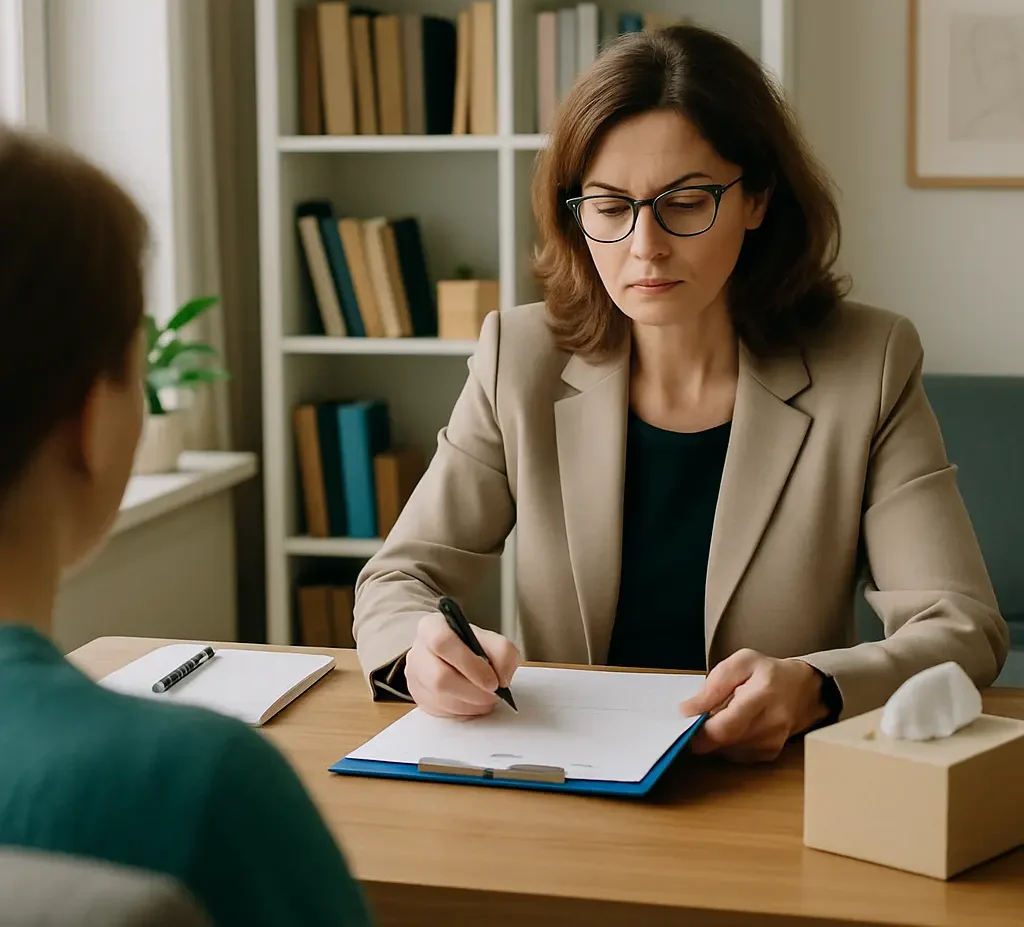Depression treatment guidelines help doctors and therapists give better care to people with depressive symptoms.
Anat Joseph, LCSW, PsyA, a licensed therapist and psychoanalyst, uses these clinical practice guidelines to support patients of all ages. Knowing how these rules work can help patients and families make smart choices.
Understanding Clinical Guidelines for Depression
Clinical guidelines for depression are expert-backed rules that show the best ways to treat depression. They help guide diagnosis, treatment, and follow-up care.
In the United States, groups like the American Psychiatric Association (APA), the Department of Veterans Affairs, and the American College of Physicians create these guidelines.
These clinical practice guidelines for depression help standardize mental health care across the country.
Doctors use interviews and tools like the PHQ-9 to diagnose depression. These tools help tell the difference between normal sadness and major depressive disorder.
The NICE guidelines from the UK are also well-known. They use a stepped-care model that starts with basic support and moves up to stronger treatments if needed.
Does stress cause depression? Many guidelines also explore how stress can contribute to the development of depressive symptoms.
Guideline Comparison Summary:
- APA: Offers either therapy or antidepressants as first options.
- ACP: Suggests therapy or medication, and often both for moderate to severe cases.
- VA/DoD: Uses strong rating systems and avoids newer drugs without enough evidence.
Treatment Recommendations and Options
Treatment guidelines for depression suggest therapy, medication, or both. For mild cases, cognitive behavioral therapy (CBT) is often the first line of treatment.
Moderate or severe depression may need CBT, antidepressant medication, or both. People with severe symptoms may benefit most from combining both treatments.
Choosing a medicine depends on the person’s symptoms and medical history. SSRIs like sertraline and escitalopram are common first picks.
Bupropion is helpful for low energy or sexual side effects. Mirtazapine can help with poor sleep and appetite. Please consult your physician before making any medical or medication-related decisions.
If someone has treatment-resistant depression (not improving after two medications), guidelines suggest switching drugs or adding another treatment. Options include adding aripiprazole or lithium, or combining therapy with medicine.
How to manage anxiety and depression is a common concern addressed in both clinical care and treatment guidelines.
Many guidelines follow a stepped-care model. Care begins with simple assistance, such as education or self-help tools. If that doesn’t work, it moves to stronger treatments like antidepressants or specialist therapy.
Generation antidepressants, such as SSRIs and SNRIs, are commonly used in the early stages of care.
In addition to CBT, other therapy approaches include psychoanalysis and the psychodynamic approach.
These help patients explore deeper emotional patterns and early life experiences contributing to depression.
Treatment Phases and Duration
The treatment of depression is structured in three stages: acute, continuation, and maintenance.
The first step focuses on getting symptoms under control. The second step helps prevent relapse. The third step keeps depression from coming back.
The 5 R’s of depression help track progress:
- Response: Symptoms start to improve
- Remission: Most or all symptoms are gone
- Recovery: The person returns to normal life
- Relapse: Symptoms come back soon after treatment
- Recurrence: A new episode happens later
Experts suggest staying on treatment for at least six months after feeling better. People with a history of chronic or repeat depression may need long-term care.
Can depression cause body aches and pain? Many patients also experience physical symptoms that must be managed during each treatment phase.
The treatment of major depression often includes extended therapy and ongoing medication to reduce the risk of relapse or recurrence of depressive symptoms.
Three Key Phases of Depression Treatment:
- Acute Phase (6–12 weeks): The Goal is symptom relief.
- Continuation Phase (4–9 months): The Goal is to prevent relapse.
- Maintenance Phase (12+ months): The Goal is to stop depression from coming back.
Age-Specific Guidelines
For teens, therapy like CBT or interpersonal therapy should come first. If that doesn’t help, doctors may consider medicine. When using antidepressants in youth, close monitoring is key.
Older adults need special care. Doctors must think about other health problems and possible side effects. Lower doses and slow increases are often safer.
Anat Joseph works with both children and adults. She adjusts treatment plans to match each person’s age, life stage, and needs.
Complementary and Alternative Treatments
Some people choose options outside standard care. Guidelines now include these when standard treatments are not possible.
Light therapy can help with seasonal and even non-seasonal depression. Exercise also has proven benefits. St. John’s Wort may help alleviate mild symptoms, but it can interact with other medications. Please consult your physician before starting any herbal or alternative treatments.
Natural remedies for depression, anxiety, and stress are popular for those seeking complementary options.
These options are useful when regular care isn’t available. Still, they should not replace main treatments for moderate to severe depression.
Monitoring, Support, and Follow-Up
Guidelines recommend that doctors check in frequently. This helps track progress, side effects, and whether the treatment is working.
Tools like the PHQ-9 and GAD-7 help measure symptoms and adjust treatment. They also help catch early signs of relapse.
The “3 C’s of depression” help people stay on track:
- Catch it early
- Continue treatment
- Communicate with providers
These steps are part of Anat Joseph’s approach. She focuses on clear communication and building trust with each patient.
Ongoing support helps patients stay well, manage stress, and avoid new episodes of depression.
Patients with depression, especially those with chronic depressive disorders, benefit from continuous follow-up and tailored plans to support recovery.
Your Next Steps
If you or someone close to you is dealing with depression, consider scheduling an appointment with Anat Joseph, LCSW, PsyA.
Her treatment plans follow clinical guidelines and are designed for your personal needs. Whether you are starting care or need help with treatment-resistant depression, support is available.
Because Your Happiness Matters.

